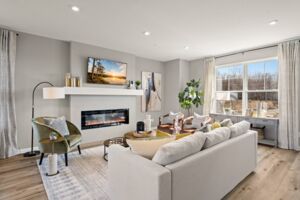
Understanding Builder Incentives: Closing Costs, Rate Buydowns, and More
Posted by Dan O'Malley in Home Design
It’s no surprise that each floorplan can pose different challenges when it comes to arranging furniture, from living room furniture placement to bedroom furniture placement.
Many people hope to create a warm and inviting atmosphere for friends and family to relax and easily engage with one another.
Whether you’re relaxing with family at the end of a long day, or entertaining friends, continue reading to understand how you can make your living room furniture placement work for any floorplan layout so you can feel comfortable and at ease.
These easy-to-apply principles can act as a guide when you are trying to fill an empty room, yet find it difficult to visualize proper furniture placement.
If you’re on the fence about a re-design in your home, find out some common signs it might be time to update in your home.
Understanding what’s important when you’re in your home is the first step in defining the space and what elements you wish to include when deciding on furniture placement:
Determining the function of the space and how you want to feel and utilize this space in your home is a good first step before arranging furniture.
Lauren Flanagan with The Spruce mentions that it’s best to start with a focal point. Natural focal points such as a prominent window or fireplace is a good start.
Or perhaps it’s a piece of furniture that you just love and want to build around that. Whatever you chosen focal point, stick with it and arrange the rest of your furniture around that as best as you can.
Laura Cerrano, a certified feng sui expert who gives advice on feng sui furniture placement, advises readers to make sure there is flow of movement to and around the furniture, making it accessible and unobstructed.
Cerrano advises, “It’s helpful to style your sofa away from the wall: whether you’re arranging it across from accent chairs in the center of the room or even just moving it out a few inches, keeping furniture from touching walls adds an open, breezy feeling in your space.”
A good rule of thumb is a couple feet between furniture pieces and at least a few inches from the wall.
As a general rule, living room furniture placement should allow family members and visitors in the home to face each other, enhancing comfort for those in conversation.
It’s not always necessary to place furniture straight on but should be close. Keep the distance from one furniture piece to the next a comfortable distance to maintain intimacy.
If you have a large space, it’s better to create separate conversation areas, rather than space furniture too far from one another as this will appear disjointed.
Find out how to enhance your space by getting creative with coffee tables.
Lighting plays a huge role in providing a balance between functional use, introducing a design element, and adding ambiance.
It’s best to incorporate a mixture of table lamps, overhead lighting, and floor lamps. Sconces are also a great lighting element to add, if possible.
A floor lamp is appropriate to use next to a sofa or behind an accent chair, and table lamps look best on end tables, dressers, shelving, or even fireplace mantels.
Eleanor Busing with Apartment Therapy discusses the importance of avoiding lone furniture placement
When a cozy armchair or lone loveseat is placed without anything next to it in a room, it gives it a sterile look.
Busing says, “Whenever you have somewhere comfortable to sit, make sure there’s also a surface next to it where you can place a cup of tea, a light to read by, or at the very least, a buddy chair so two people can sit and chat together.”
Sometimes living with your furniture layout for a month and then switching it around or shifting a few pieces can give you a whole new perspective. It almost changes the dynamic of the entire room.
You may come to realize one layout is more suited towards your lifestyle, or simply just feels better, than the way you previously arranged it. Don’t be afraid to make adjustments along the way to find what really works for you!
You can follow all the rules and tips, but in the end, it’s always best to remember this is your home, not a showroom. There will be messes, and that great new couch might look amazing, but is it comfortable too and does it function well in real life?
Sometimes function wins over form and it’s best to remember your home is your sanctuary, and, above all, it should provide a comfortable space you feel good in.
Come see how the professionals do it! Tour model homes in your area that have been professionally decorated with the above-mentioned principles in mind, providing you with furniture placement ideas to apply in your own home.

Author
Dan O’Malley is the Vice President of Product Development for M/I Homes.With over 30 years of expertise in residential architecture and design, Dan has been overseeing the product needs of the company's 16 divisions located throughout the Midwest, Southeast, Nashville and Texas for the past 12 years. Before joining M/I Homes, he was a partner in the Chicago office of BSB Design, a national residential architectural firm, for 14 years. Dan is an expert in all aspects of single-family and multifamily design and has received several awards for his successful projects. He is also a popular speaker at various industry events, including the International Builder’s Show, Midwest Builder’s Show, and Multi-Housing World.
Understanding Builder Incentives: Closing Costs, Rate Buydowns, and More
Moving to Orlando: The Ultimate Relocation Guide

Author
Dan O’Malley is the Vice President of Product Development for M/I Homes.With over 30 years of expertise in residential architecture and design, Dan has been overseeing the product needs of the company's 16 divisions located throughout the Midwest, Southeast, Nashville and Texas for the past 12 years. Before joining M/I Homes, he was a partner in the Chicago office of BSB Design, a national residential architectural firm, for 14 years. Dan is an expert in all aspects of single-family and multifamily design and has received several awards for his successful projects. He is also a popular speaker at various industry events, including the International Builder’s Show, Midwest Builder’s Show, and Multi-Housing World.


